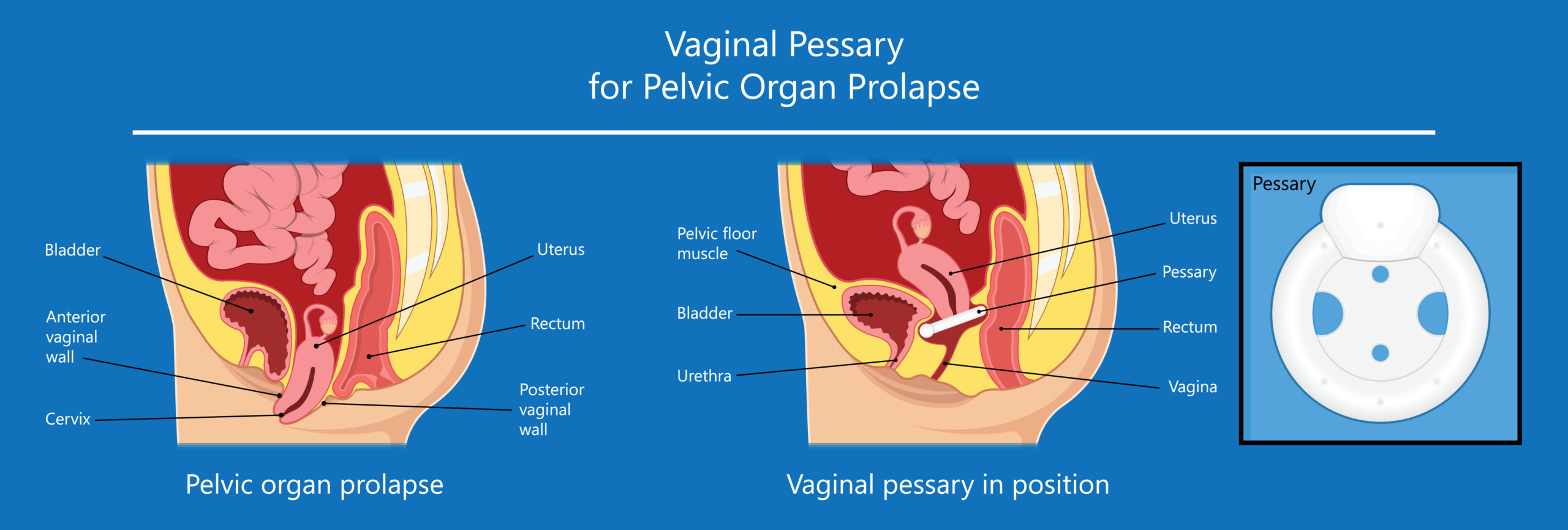
Pessaries: A Non-Surgical Treatment Option for Pelvic Organ Prolapse
Pelvic organ prolapse is a condition that affects millions of women worldwide. It occurs when the pelvic muscles and tissues become weak, causing the pelvic organs to drop and press against the vaginal walls. This can lead to discomfort, pain, and even difficulty with urination or bowel movements. While there are various treatment options available for pelvic organ prolapse, one non-surgical option that has gained popularity in recent years is the use of pessaries.
What Are Pessaries?
Pessaries are medical devices that are designed to support the pelvic organs and prevent them from dropping further. Stress incontinence can also be managed with the use of a pessary. Stress incontinence is urinary leakage that occurs with events such as when you cough, sneeze, laugh, lift, or strain.
Pessaries are typically made of silicone or latex. They come in a variety of shapes and sizes to fit each woman’s unique anatomy. They are inserted into the vagina and are held in place by the vaginal walls.
The initial insertion is done by your healthcare provider. Once the right shape and size has been determined, you can be taught to remove and insert the pessary on your own. The pessary does need to come out for cleaning but this schedule can be tailored based on preference. Some people have difficulty manipulating a pessary on their own, or they might just not want to deal with it on their own. These individuals may choose to leave the pessary in place for months at a time and come into the office to have a healthcare provider remove it, clean it, and reinsert it. Either option is fine and safe to do.
How Do They Work?
Pessaries work by providing support to the pelvic organs and redistributing the weight of the organs to reduce pressure on the vaginal walls. This helps to alleviate symptoms of pelvic organ prolapse, such as a feeling of pressure or fullness in the pelvic area, a bulge or lump in the vaginal area, discomfort or pain during sex, urinary problems, and bowel problems. Think of a pessary as working similar to a brace. It provides support while the device is in place.
The image below shows only type of pessary but there are several different shapes available. Your healthcare provider will determine which shape is appropriate for your specific prolapse or incontinence needs.

Vaginal Pessary for Pelvic Organ Prolapse
What Are the Benefits of Using Pessaries?
There are several benefits to using pessaries as a treatment option for pelvic organ prolapse, and stress incontinence:
- Non-surgical: Unlike surgery, pessaries are a non-surgical option for treating pelvic organ prolapse. This makes them a good option for women who are not candidates for surgery or who prefer to avoid surgery. It can also be a good option if your prolapse only bothers you in certain circumstances, such as during exercise.
- Customizable: Pessaries come in a variety of shapes and sizes to fit each woman’s unique anatomy. This means that they can be customized to provide the best support and comfort for each individual woman. There are many different shapes and sizes of pessaries. We tell people that trying pessaries is like trying on shoes. It can take a few tries to find the perfect fit. If one pessary does not work for you, don’t worry. There are other pessaries that might work better for your needs.
- Reversible: Pessaries can be easily removed if they are causing discomfort or if a woman no longer needs them.
- Cost-effective: Pessaries are generally less expensive than surgery and can be a cost-effective option for women who are on a tight budget.
What Are the Potential Drawbacks of Using A Pessary?
While pessaries are generally a safe and effective treatment option for prolapse, there are some potential drawbacks to consider:
- Maintenance: Pessaries need to be removed and cleaned regularly to prevent infection and odor.
- Discomfort: Some women may experience discomfort or irritation when using a pessary.
- Need for replacement: Pessaries may need to be replaced over time, which can be inconvenient.
- Allergy: Some women may be allergic to the materials used in pessaries, which can cause irritation or an allergic reaction. However, this is uncommon and should not prevent you from trying a pessary if you are interested in doing so.
How Are Pessaries Inserted?
Pessaries are typically inserted by a healthcare provider during a pelvic exam. The healthcare provider will select a pessary that is the appropriate size and shape for the woman’s anatomy and will insert it into the vagina. The pessary will be adjusted as needed to ensure that it is providing the best support and comfort for the woman.
Are Pessaries Right For You?
If you are experiencing symptoms of pelvic organ prolapse, such as a feeling of pressure or fullness in the pelvic area, a bulge or lump in the vaginal area, urinary problems, or bowel problems, speak with your healthcare provider. Your healthcare provider can perform an exam and discuss treatment options with you, including the use of a pessary. Pessaries are a safe and effective non-surgical option for treating pelvic organ prolapse, and they may be the right choice for you.
Connect With Us
Be sure to check our blog regularly for new posts, and follow us on Facebook and Instagram @PeterMLotzeMD for health and wellness tips and more!
Need to schedule an appointment with Dr. Peter Lotze and his team? Please contact our office directly.



